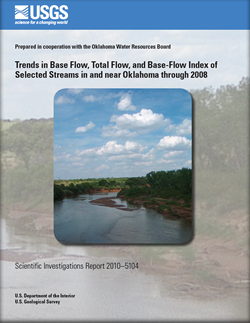Scientific Investigations Report 2010–5104

The U.S. Geological Survey, in cooperation with the Oklahoma Water Resources Board, investigated trends in base flow, total flow, and base-flow index of selected streams in Oklahoma and evaluated possible causes for trends. Thirty-seven streamflow-gaging stations that had unregulated or moderately regulated streamflow were selected for trend analysis. Statistical evaluation of trends in annual and seasonal (winter-spring and summer-autumn) base flow, total flow, and base-flow index at 37 selected streamflow-gaging stations in Oklahoma was performed by using a Kendall’s tau trend test. This trend analysis also was performed for annual and seasonal precipitation for nine climate divisions in the study area, annual peak flows, the number of days where flow was zero or less than 1 cubic foot per second (both annually and seasonally), and annual winter groundwater levels for 35 shallow wells near the analyzed stations. Precipitation-adjusted trends using LOESS regressions and Kendall’s tau were computed for annual and seasonal base-flow and total-flow volumes in order to identify the presence of underlying trends in streamflow that are not associated with annual or seasonal variations in precipitation. In general, upward trends in precipitation were detected for climate divisions in north-central Oklahoma and south-central and southeastern Kansas. More climate divisions had statistically significant upward trends in total precipitation for annual water years than in winter-spring or summer-autumn water years. Significant trends in annual or seasonal base-flow volume were detected for 22 stations, 19 of which had trends that were upward in direction. Significant trends in annual or seasonal total-flow volume were detected for 14 stations, 9 of which had trends that were upward in direction. Most stations that had significant upward trends in annual or seasonal total-flow volume also had significant upward trends in base-flow volume for the same period. Precipitation adjustment changed the results (significant only or significance and direction) of significant annual or seasonal trends in unadjusted base-flow volume for 12 stations and in unadjusted total-flow volume for 13 stations. Significant trends in annual or seasonal base-flow index were detected for 25 stations, 23 of which had trends that were upward in direction. Eighteen stations that had significant upward trends in annual or seasonal base-flow index also had significant upward trends in base-flow volume and no significant downward trends in total-flow volume during the same period, which indicated that upward trends in base-flow index were likely driven by increases in base flow at these stations. Trend results were highly variable throughout the State. However, some recurring patterns in locations of stations with similar trend results were detected. In general, significant downward trends in base-flow and total-flow volumes were detected for the three stations in the Oklahoma Panhandle. Significant upward trends in annual or seasonal base-flow volume before and after precipitation adjustment were detected for 12 stations in southwestern and central Oklahoma. In eastern Oklahoma, significant upward trends in annual or seasonal base-flow volume were only detected for 4 stations, and significant upward trends in annual or seasonal total-flow volume were only detected for 1 station. After precipitation adjustment no stations in this region had significant upward trends in either parameter, one station had significant downward trends in annual base-flow volume, and one station had significant downward trends in winter-spring total-flow volume. Increases in annual and seasonal precipitation, especially during a substantial wet period (1980-2000), may be one of the factors resulting in upward trends in base-flow volume and total-flow volume at many of the stations analyzed in this report. Eleven stations with significant upward trends in precipitation-adjusted annual and winter-spring base-flow volume were located in or near principal aquifers where many wells had significant upward trends in groundwater levels. Significant upward trends in annual or seasonal base-flow index were detected for all of these stations. Significant upward trends in base-flow volume and base-flow index for these stations may indicate increased recharge of underlying aquifers as a result of increases in precipitation, artificial recharge from irrigation returns, or changes in irrigation practices in the region. Downward trends in base-flow volume and total-flow volume in the Oklahoma Panhandle likely are caused by long-term declines in groundwater levels and surface-water diversions for irrigation. |
First posted September 1, 2010 For additional information contact: Part or all of this report is presented in Portable Document Format (PDF); the latest version of Adobe Reader or similar software is required to view it. Download the latest version of Adobe Reader, free of charge. |
Esralew, R.A., and Lewis, J.M., 2010, Trends in base flow, total flow, and base-flow index of selected streams in and near Oklahoma through 2008: U.S. Geological Survey Scientific Investigations Report 2010–5104, 143 p.
Abstract
Introduction
Selection of Data for Analysis
Methods of Analysis
Trends in Base Flow, Total Flow, and Base-Flow Index
Groundwater Level Trend Analysis
Evaluation of Potential Causes of Trends
Summary
References Cited